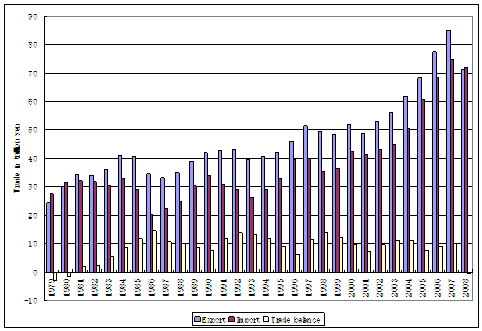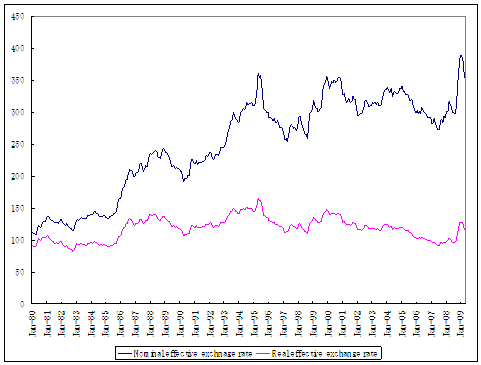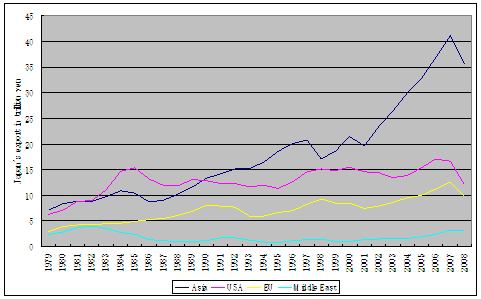By Eiji Fujii
Today, we’re fortunate to have Eiji Fujii, Professor of Economics at Tsukuba University as a guest blogger.
Shaken by the world financial crisis, Japan has recorded the first trade deficit (on the April-March fiscal year basis) in 28 years (see Figure 1). The trade balance of the 2008 Japanese fiscal year was about -725 billion yen. The last trade deficit (on the fiscal year basis) was recorded in 1980 when the second oil crisis hit the economy hard.

Figure 1: Japan’s trade balance (April-March fiscal year basis, in trillion yen). Exports (blue bar), imports (red bar), trade balance (yellow bar). Source: Japanese Ministry o f Finance.
Shrinking demand overseas, particularly in the US, is clearly the main factor in this development. However, the unique status of the yen as a safe haven in the midst of the global financial turmoil can also be held partly responsible. In the initial stage, the fact that the Japanese financial sector did not have much presence in international markets worked in Japan’s favor as Japanese financial firms had relatively little exposure. However, the irony is that temporary safe haven effect caused a steep appreciation of the currency (see Figure 2). This added further impetus to the decline in Japanese exports already being driven by rapidly diminishing demand around the world for Japanese goods.

Figure 2: Yen nominal (blue) and real (pink) effective exchange rates (1973=100, a rise of the index values means appreciation). Source: Bank of Japan.
It is no surprise to see the Japanese exports to the US and EU plummeting following the financial crisis. But a body blow to the Japanese economy came from the substantial drop of its exports destined to other Asian economies (See Figure 3). Some of these exports may have the US and Europe as their final destinations.

Figure 3: Japan’s exports by destination (in trillion yen). Asia (blue), USA (pink), EU (yellow), MidEast (light blue). Source: Japanese Ministry of Finance.
Are the Japanese welcoming the resolution of the long time trade imbalance — lending overseas too much too long? Clearly not at the moment, when the domestic demand remains rather fragile.
Post written by Eiji Fujii.
at what $ exchange rate will japan’s gdp be crushed by an overvalued yen? in the past japan manipulated their currency, although it seems this practice has been stopped for several years now…but i expect it to begin again, if japan’s economic situation is threatened by their exchange rate. remember when the yen hit 85 about a year ago, it was a safe and lucrative bet it couldn’t go higher because a sustained rate of 85 meant the export game was over for japan. if the market hadn’t taken immediate corrective action, japan would have been forced to sell yen. now, however, i suspect the trigger rate is higher, perhaps 90-92, since global demand has continued to decline on it’s own, squeezing japan’s exports independent of the yen’s exchange rate. anyone have any other thoughts on the yens exchange rate.
but if private consumption and investment stay subdued, near term imports will suffer too. So for the moment there’s no resolution of the long term gap. Furthermore, trade with China should resume soon, helping exports stabilization.
I’ll believe China is leading the way out when it actually happens.
One observation and one question. The observation is that the “safe haven” status you give to the yen also probably had a large component that represented unwinding of yen funding of carry trade assets, including ABS and the like. The carry trade and use of cheap yen funding for a range of assets kept the yen cheap in 2005 – 2007 only to drive it to appreciate when this funding unwound.
To what extent to emperics sho show the collapse in yen exports as a result of real exchange rate appreciation? I find this conclusion surprising because the degree of yen appreciation does not seem large enough to create such a dramatic fall in exports and with such short lags. My bias is to see the collapse as coming from export structure – autos seemed to have a lot to do with it – and the collapse in trade finance.
An eventual Current Account Deficit is a good thing for Japan to look forward to. Japan’s policies of selling Yen and buying dollars over the years has led to oversaving on behalf of the Japanese economy. Japan needs to consume more to balance out the lower levels of consumption on behalf of the US.
Japanese consumption should not be seen as a the “saviour” of the world economy by any means – but what it will do is help rebalance the world economy.
Nice overview, Professor. Thanks!
I do feel for the Japanese: aging population, personal savings being whittled down, wasteful government infrastructure spending, unsustainable government debt load, and, now, exports falling in this Greater Depression.
All this, and North Korea and China rattling their sabers. Yuck!
America and the Japanese have been horribly served by their central banks, and now the bill is coming due.
The proper yen-dollar exchange rate would be one at which the Japans trade with the US* would come into balance. In the mid-90’s, that was about 80 yen/dollar. Since Japanese manufacturing capability has probably increased substantially since then, while ours has declined, the competitive exchange rate for the dollar is probably even lower.
*Including its large stealth trade surplus of high-value-added components going through China on their way to the US as part of the superficially Chinese trade surplus.